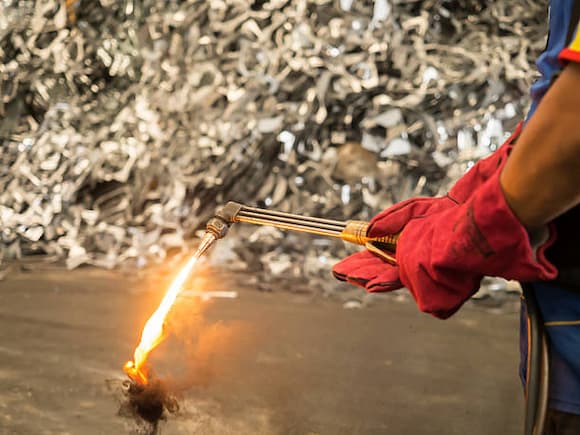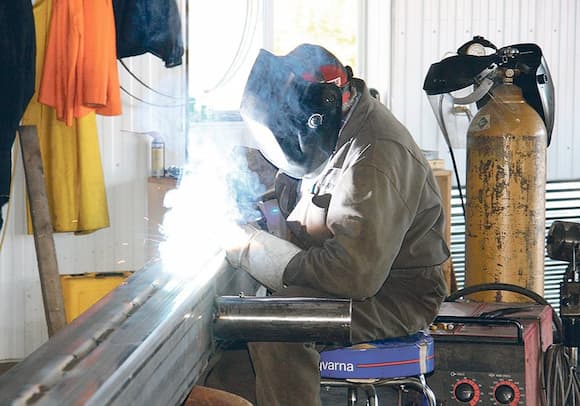If not in name, oxy acetylene welding, or oxy-fuel welding (OFW), is certainly the most easily recognizable form of welding there is. In fact, with its characteristic gas cylinders and large welding torch, the oxy welder is a symbol of the golden era of bridge and skyscraper buildings.
As a fabrication process, oxy welding utilizes the combustion of a fuel gas and pure oxygen to fuse metals like steel, iron, and aluminium without using a filler. And unlike other forms of welding, by adding a cutting torch attachment to it, an oxy welder can also be used to cut through metal up to 30cm thick.
Not surprisingly, as other forms of welding like MIG (metal inert gas) and TIG (tungsten inert gas) has grown in prominence, oxy welding has lost its industrial dominance. The need for faster welds using new types of metals has relegated the oxy-fuel process largely to niche fabrication work.
The jobs that still favour oxy-fuel processes, however, aren’t likely to be replaced anytime soon. And if you or your company are continuing to use oxy in some capacity, now might be a good time to consider upgrading your equipment.
Accomplishing With Oxy Acetylene

While it’s understandable why oxy use isn’t as prevalent as it used to be, there’s no arguing that there are still millions of professionals and hobbyists who use it regularly. That’s why a whole new generation of medium and heavy-duty oxy acetylene torch kit and cutting sets are available now, and they’re more portable, safer, and longer lasting than ever.
Heated metal fabricators know that when it comes to welding, cutting, and brazing, the precision that’s possible when performing oxy-fueled fabrication is hard to beat. The risk, however, of working with dried-out or damaged hoses, sticky regulators, or potentially defective torches makes periodically investing in new oxy-acetylene kits and equipment a necessity. With today’s high-quality equipped kits though, oxy-fuel process fabricators have all the benefits of:
- Lighter weight aluminium torches;
- Better resistance to flashbacks;
- Larger inside diameter hose sizes for increased gas flow;
- Quicker starting and better flame stability; and
- Improved mixing increases gas savings.
With a complete new oxy-acetylene kit, businesses and fabricators can accomplish more, safer. All they need to supply are the gases and the expertise, and the kit supplies everything else.
What’s in an Oxy Welding Kit?
For most professional fabricators, the advantage of oxy-fuel processes is their portability. A professional-grade portable oxy acetylene torch kit puts all the equipment that’s needed to tackle the full range of oxy-fuel processes into a convenient carrying case that’ll fit into the backseat of any car or ute, and is ready for use anyplace, anytime. A top-quality oxy-acetylene kit for sale consists of these main components:
2 Pressure Regulators
The pressure regulators supplied with oxy-fuel kits control the flow of gases from the fuel gas and oxygen cylinders into the gas hoses feeding the torch. These are two-stage regulators, with the first stage responsible for maintaining constant cylinder release pressure and the second stage controlling the pressure on the hoses. A new oxy torch kit includes 2 colour-coded regulators: one for oxygen, and one for the fuel gas, i.e. acetylene, propane, or propylene. Not all gases are ideal for every job though, and fabricators need to exercise caution when setting cylinder outlet pressures.
2 Gas Hoses
A new portable oxy acetylene set will also include twin, colour-coded gas hoses. These gas hoses are designed with a range of abrasion, temperature, and flame-resistant properties, and their sizes and pressure limits will vary depending on whether the set is intended for medium or heavy-duty fabrication. Gas hoses are also rated specifically for the properties of fuel gas being transited. It means that if a fuel gas other than the type specified by the kit’s regulator is to be used, caution needs to exercise to ensure that the fuel hose is safe for use with it.
1 All-purpose Torch Body
The kit’s new oxy-fuel torch body is responsible for receiving and regulating the combustible oxy-fuel combination that’s fed through the gas hoses. Manual adjustment valves on the handle of the body enable precision mixing of oxygen and fuel gas ratios; and the kit’s selection of tips and attachments allow the torch to perform its full range of cutting, welding, heating, and layering fabrications. A superior acetylene torch set will also feature inlet-mounted flashback arrestors which, in the event of an uncontrolled burn, will prevent the torch flame from potentially going back into the hoses.
In short, when you buy a modern portable oxy acetylene kit, you’re buying a comprehensive package that’s built to work just as hard as the individual doing the fabricating. And with regular maintenance and consumable replacements like arrestors and check valves, a new kit will provide years of reliable service.
Keeping Oxy-Fuel Kits Reliable

Although it typically goes unsaid, an oxy-fuel setup’s reliability depends largely on the fabricator using it. By the nature of its design, a professional oxy acetylene set can be expected to put in decades of indoor and outdoor service, in all kinds of weather. There are a handful of precautions, however, that can be taken that’ll help extend their serviceability even further, such as:
- Ensuring the regulator is the correct type for the fuel gas being used;
- Double checking the tightness of the gas cylinder, regulator and torch connections before every use;
- Immediately replacing hoses with any sign of damage;
- Using only appropriately sized tips for the equipment; and,
- Purging gas hoses before every use, and bleeding them after every use.
In addition to the basic protections that need to be taken with any type of welding, these points ensure that fabricators can continue to safely use their new oxy-acetylene torch set for a long time.
The Final Word
At the end of the day, while oxy-fueled fabrication may not be as common as it was, it’s still the preferred method for custom and intricate metal works. A lot of fabricators who’ve largely moved onto MIG and TIG welding still keep the oxy-fuel rigs around, just in case; and when it comes to salvage or heavy metalworks that involve cutting thick steel, no other process comes close to its efficiency.
A new oxy acetylene torch kit, however, can let you or your company take advantage of the innovations built into new equipment. Fabricators will feel safer using new oxy-fuel equipment too, and that alone makes it a worthwhile investment.
